Red color horses are some of the most beautiful in any breed.
Horses with red coats are called chestnut or sorrel. The term “sorrel” is usually used in Western riding, while “chestnut” is the term most often used in English riding.
Although technically chestnut and sorrel are considered different shades of the red coat color, together with bay–a reddish-brown or brown coat with black points–red is one of the most common horse colors.
Chestnut or sorrel horses have reddish-brown bodies and legs, with red manes and tails.
An important characteristic of red horses is that, unlike bay horses, they have no black pigment on their coats, so they will never have black on their legs or have black manes or tails.
The color of a red horse’s tail and mane may go from a light blonde, almost flaxen color, to an almost black-looking brown color.
While many horse breeds can have a red coat, there are some breeds, such as the Suffolk Punch and the Frederiksborg Horse whose traditional color is always red.
Read along to learn about some of the most common red breeds!
Table of Contents
1. Suffolk Punch
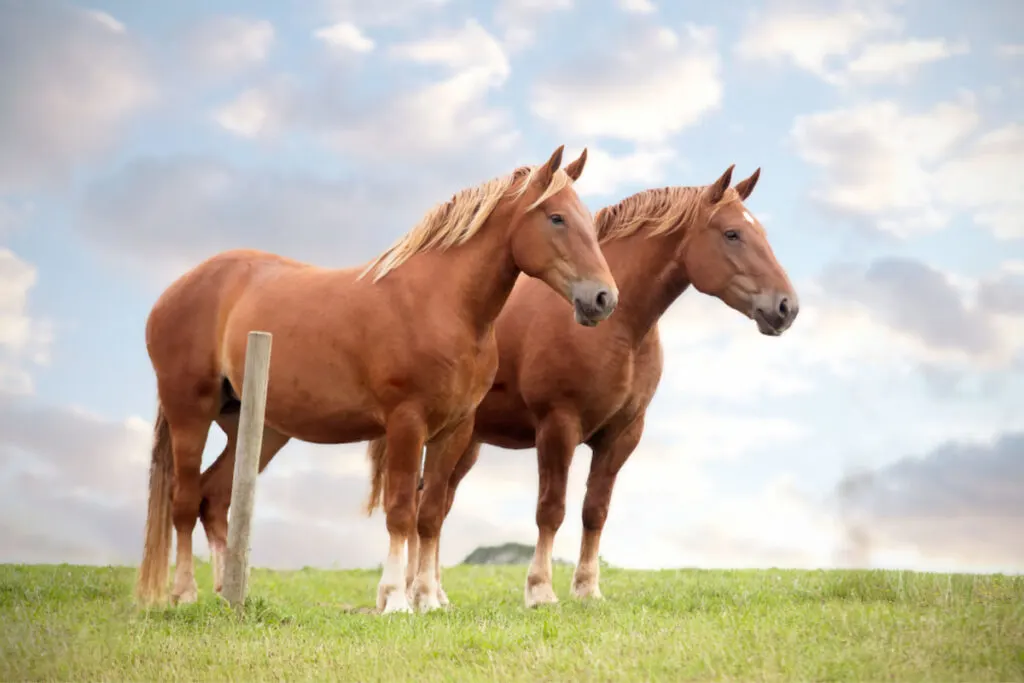
The Suffolk Punch is a small draft horse that originated in Suffolk, England. It is also known as the Suffolk horse or Suffolk draft horse, this breed’s coat color is always chestnut.
True to chestnut color’s wide variety of shades, the Suffolk Horse Society lists 7 historically defined shades: Dark Liver, Dull Dark, Light Mealy, Red, Golden, Lemon, and Bright.
Nowadays, the Society accepts Liver, Dark, Red, Light, or Bright chestnut shades.
Traditionally, when referring to the Suffolk horse, the word “chestnut” is spelled “chesnut,” so it is not a spelling mistake you are seeing while reading about this horse.
Originally bred to work the land and plow fields, Suffolk horses are muscular and strong, with a broad head and thick neck.
Because of their compact and muscular bodies, the legs of Suffolk horses seem a bit short in comparison to their bodies.
2. Frederiksborg Horse
Originating from Denmark in the 16th century, the Frederiksborg horse is one of the oldest domestic horse breeds in the world.
This beautiful horse is always chestnut, often with a flaxen mane and tail.
What distinguishes this horse from other chestnut breeds, is its white markings, which can be in the face, legs, or other parts of the body.
Other characteristics of the Frederiksborg are its long, slightly convex face and its large, expressive eyes.
The Frederiksborg horse is agile, with an athletic build and a calm and friendly temperament and they were hugely popular throughout the 19th century.
Unfortunately today, there are only small numbers of the Frederiksborg horse.
3. Quarter Horse
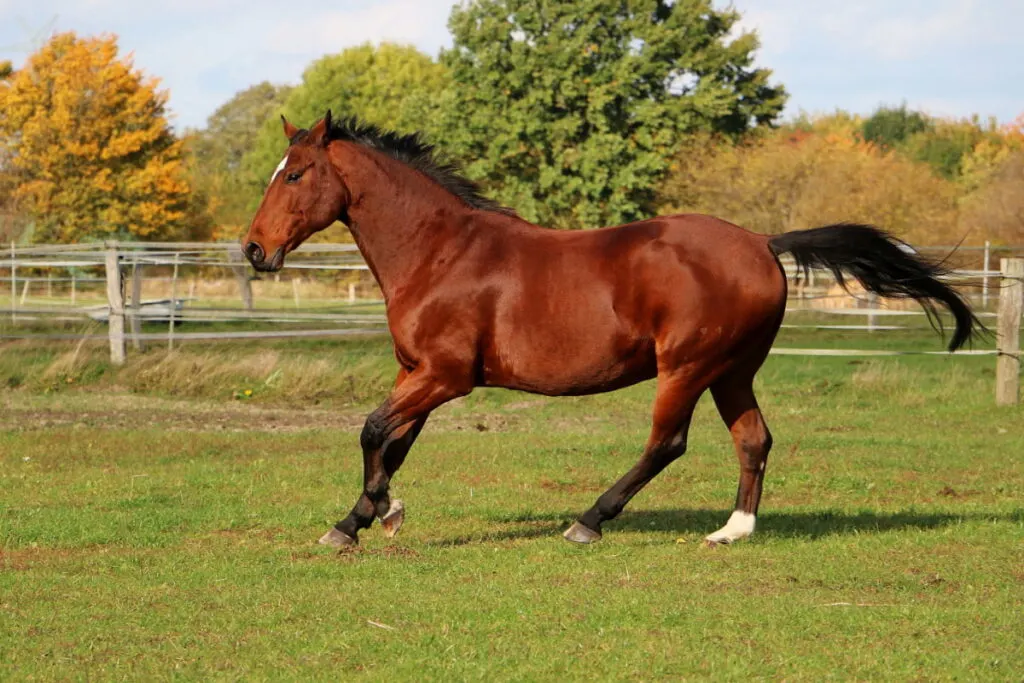
If you love horses, you are probably already familiar with Quarter Horses: it remains the most popular horse breed in the United States.
The American Quarter Horse Association recognizes 17 coat colors. However, the most common coat color for the Quarter Horses is sorrel or chestnut.
The origins of the breed go back 500 years when the Spanish conquistadors brought their Iberian, Arab, and Barb horses to the United States.
The Quarter Horse’s name is derived from its ability to sprint over a quarter-mile at full speed, the length of the race tracks during colonial times.
Over time, this horse became popular with ranchers, which developed the breed to be able to cut cattle; their speed and agility made them ideal for the work.
4. Arabian
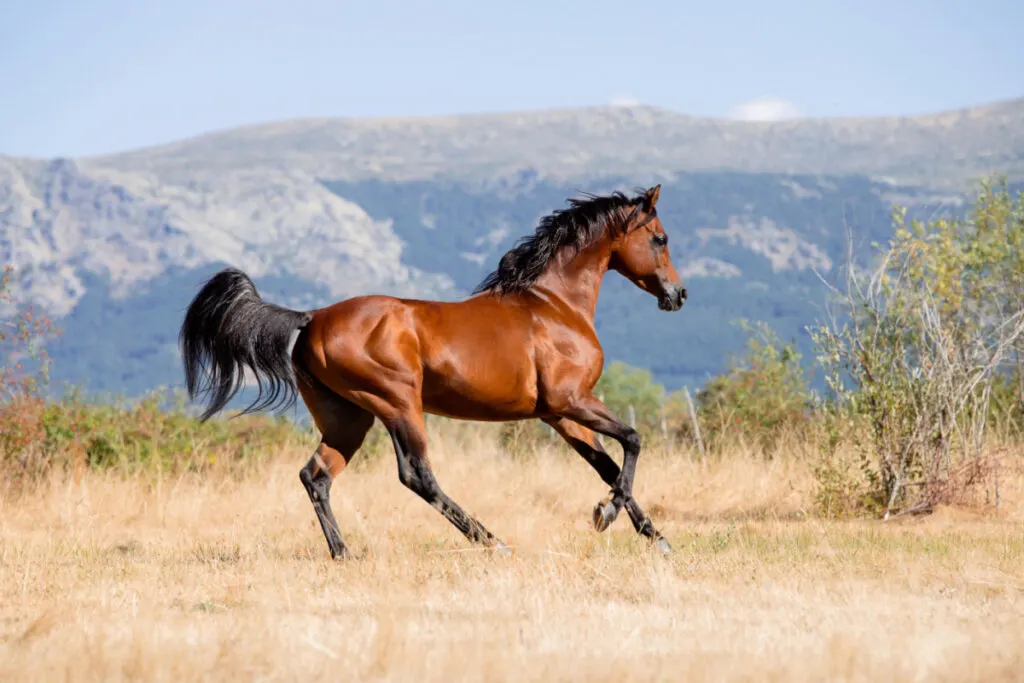
The graceful and elegant Arabian horse originated in the Arabian Peninsula several centuries ago.
Although some of their history has been lost to time and legend, there is evidence that Bedouin tribes–nomads who lived in the desert–carefully bred Arabian horses since at least 3000 BC.
Some of the most distinct characteristics of Arabians are their long, arched necks and finely structured heads, which are wider at the top and narrow towards the muzzle, giving these horses a striking chiseled look.
Arabians are classified as “hot-blooded” and they are recommended for older or more experienced riders.
The Arabian Horse Association recognizes multiple colors for Arabian purebreds, including bay, gray, chestnut, black, and roan.
However, chestnut is one of Arabians’ most common coat colors. Arabians may also display white markings such as stars or stripes on their faces and/or white stockings on their legs.
Another key characteristic of Arabians, including red Arabians, is that their skin is always black, except under white markings.
The breed developed the pigment on their skin as it evolved in the harsh desert sun.
5. Mustang
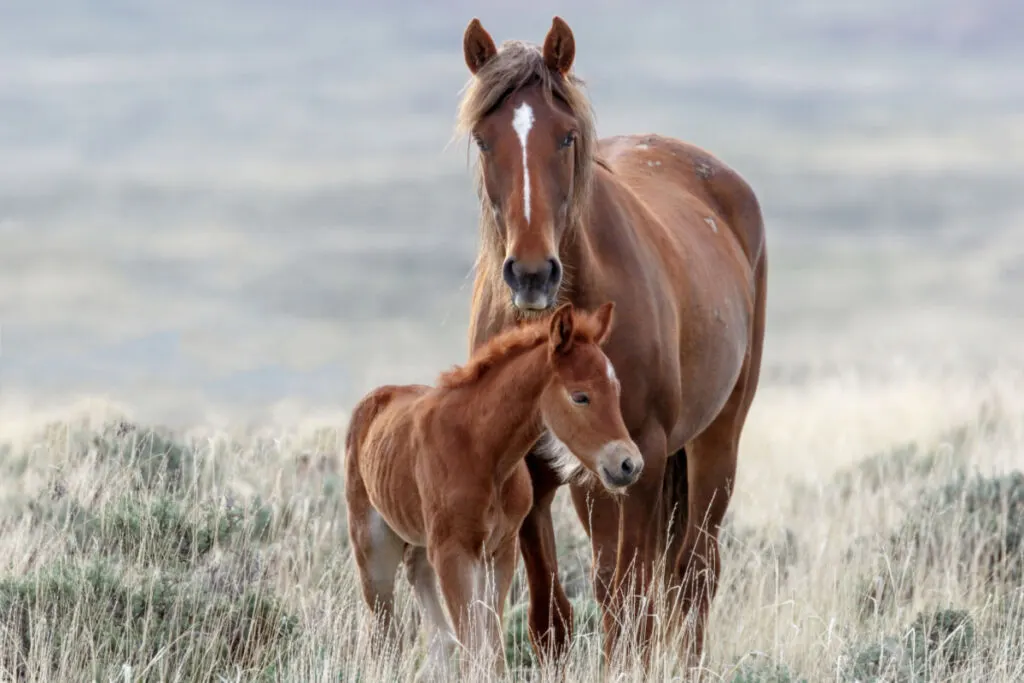
Mustangs are wild horses living in the Western United States. They are descended from the Iberian and Arabian horses brought to the Americas by the Spanish conquistadors in the 1500s.
These horses’ bloodlines were mixed with Quarter Horses, Tennessee Walker Horses, Thoroughbred, and some draft horses.
Over time, some of these horses escaped and developed into the wild Mustang.
As Mustangs descended from domesticated horses, there is still some debate about whether they should be considered “wild” or “feral.”
Mustangs are small to medium size but strong and sturdy. Mustangs’ eyes are set wider apart on their head compared to other breeds.
They also have harder, more durable hooves than domestic horse breeds. While Mustangs have many coat colors, their most usual colors are chestnut or bay.
6. Morgan
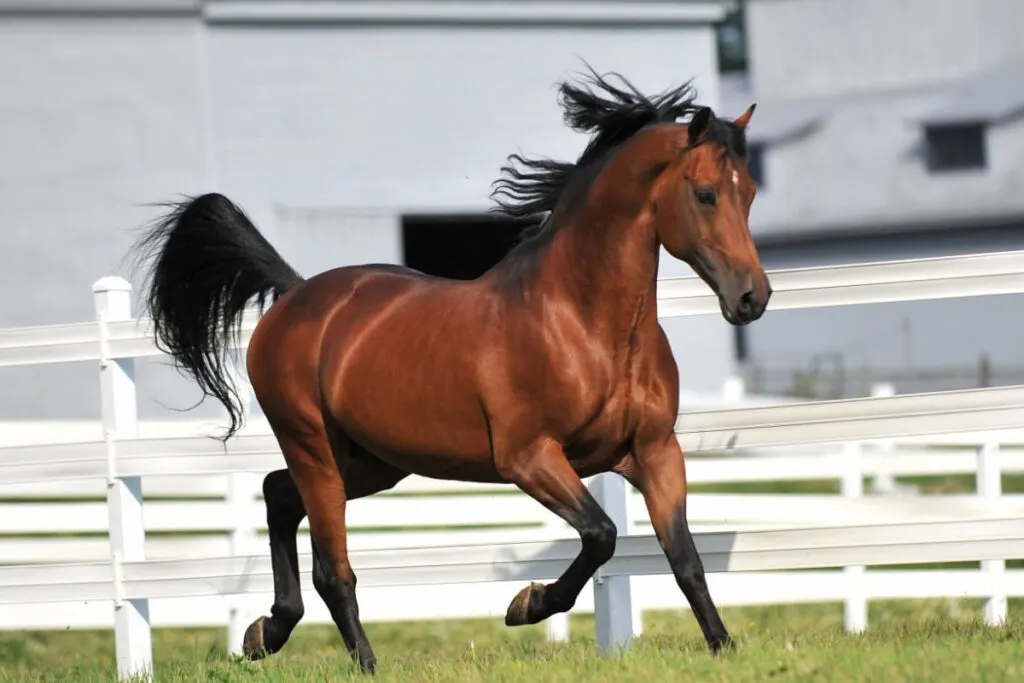
In their breed statement, the American Morgan Horse Association summarizes their vision of this classic horse with these words: “the beauty of the Morgan horse lifts the heart.”
And it’s easy to see why: the Morgan is a versatile and elegant breed that is as much at home doing ranch work as it is competing in English riding shows.
Though Morgans’ coats can be any color, most Morgans are bay or chestnut.
Compact and smaller in size, Morgans are known for their stamina and vigor, but also for their adaptable nature.
Morgans are one of the earliest American horse breeds. Their origins date back to 1789 and to a foundation sire called “Figure.”
Figure was owned by Justin Morgan, a businessman, horseman, teacher, and composer from Vermont, Massachusetts.
As was the custom of the day, Figure was known by his owner’s name, Justin Morgan’s horse, and as he sired other horses, the breed was born.
What’s even more extraordinary about Figure is that one of his sons, a horse called Sherman, contributed to the foundation of the Standardbred, American Saddlebred, and Tennessee Walking Horse breeds.
7. Belgian Draft Horse
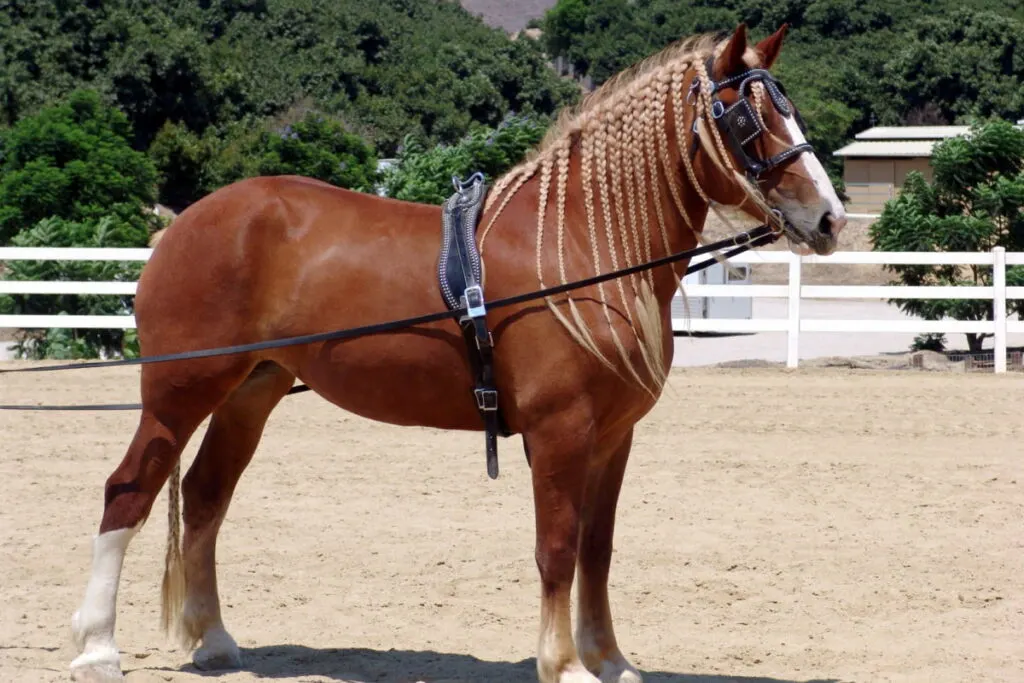
As their name indicates, Belgian Draft Horses are native to Belgium, where they were developed as strong working horses from the Brabant breed–the large Flemish horses that were reputed to have carried armored knights into battle in medieval times.
According to the Belgian Draft Horse Corporation of America, most Belgian draft horses today have chestnut, sorrel, or blonde coats.
This is due to the development of the breed in the United States, where over time breeders showed a preference for sorrel and roans (horses with coats made of an even mix of white and colored hairs).
Similar to the Frederiksborg, Belgian horses often have white markings on the face and legs.
A particular characteristic of some Belgians is their “blaze”, a large, white stripe on their face.
Belgian Draft Horses are strong and calm and willing workers and that has made them popular in pulling competitions.
They are also the most popular draft horse breed in the United States.
(Source).
8. Tennessee Walking Horse
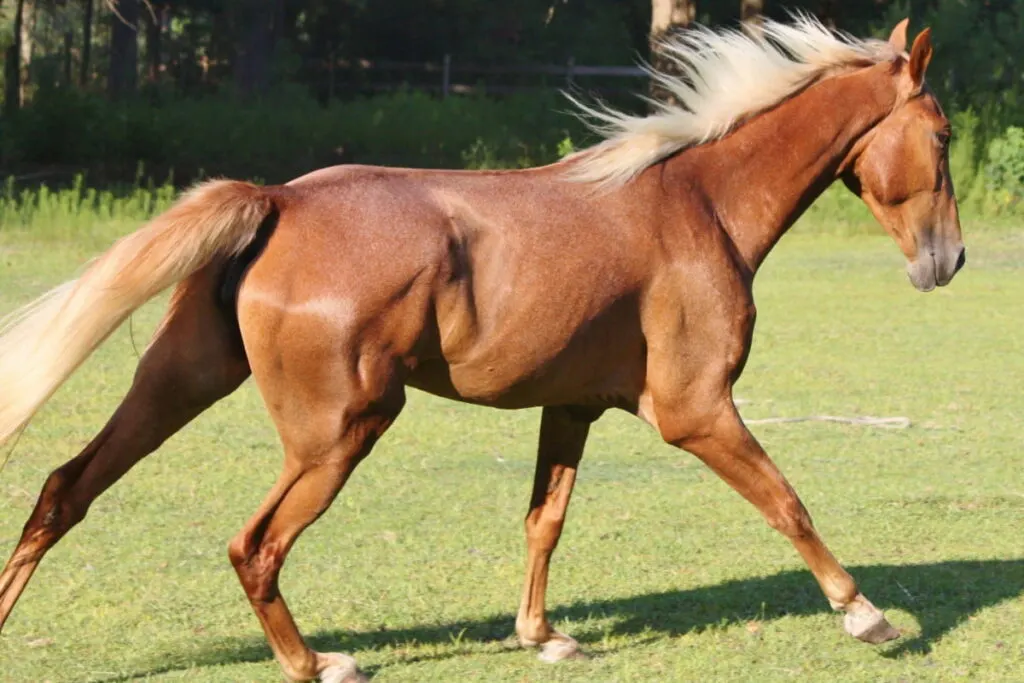
The Tennessee Walking Horse is a gaited horse first developed to work in farms and plantations in the Southern United States.
The Tennessee Walking horse is known for its natural, inherited gait, the running walk, and its two other gaits, the flat foot walk, and canter.
It was this smooth, running walk gait that made the breed a preferred choice on the large farms and plantations, and what makes this horse a great choice for trail riding today.
Physically, you may distinguish a Tennessee Walking Horse by its long sloping shoulder and sloping hip.
The Tennessee Walking Horse, also known for its calm and happy temperament, was named the official state horse of Tennessee in the year 2000.
9. Thoroughbred
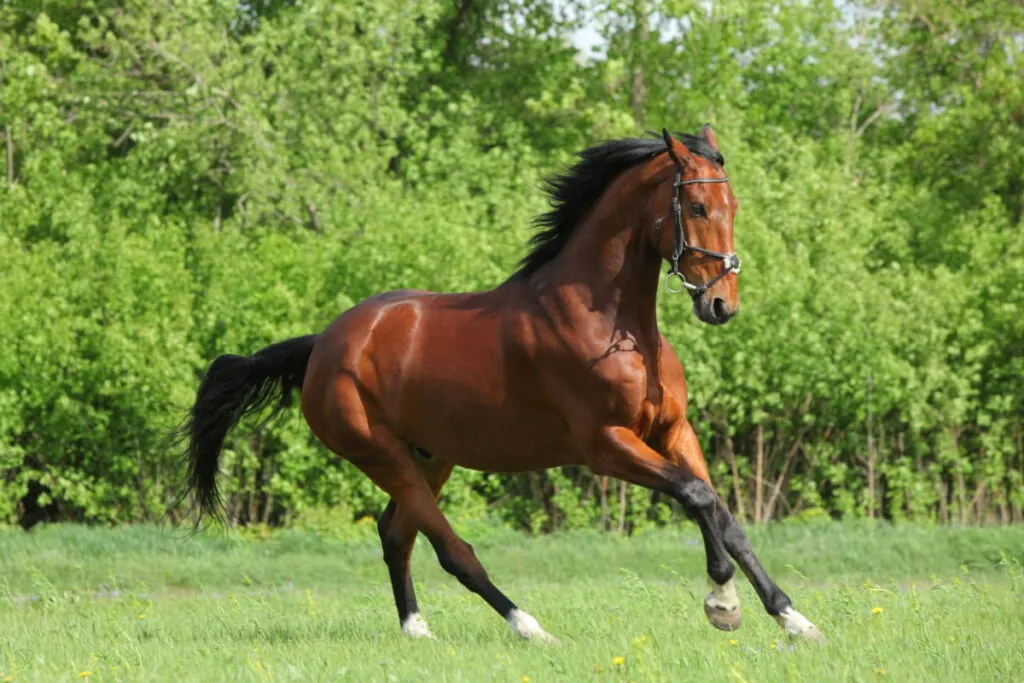
You may already be familiar with the Thoroughbred Horse, known the world over by their athleticism, usually in display through racing.
This is because Thoroughbreds were bred specifically for racing in the 17th and 18th centuries in England. The first Thoroughbreds were brought to the American Colonies in 1730.
In addition to racing, Thoroughbreds excel at jumping and dressage but are also widely used as trail horses, general riding horses, and pleasure driving horses.
Thoroughbreds are not generally recommended for beginner or young riders as they are considered to be too spirited and energetic for that skill level.
Strong and majestic, Thoroughbreds’ coats are always a solid color. Bay, black, and of course, chestnut, are some of the most common colors you will find in this beautiful horse.
Related Reading
Sources
When choosing a new horse or learning about your favorite breed, it is important to consult a diversity of sources. These are the sources we used for this article.
- https://www.britannica.com/animal/Suffolk-horse
- http://www.theequinest.com/breeds/suffolk-punch/
- https://www.suffolkhorsesociety.org.uk/the-suffolk-its-heritage-the-society/the-suffolk-horse/
- http://www.theequinest.com/breeds/frederiksborg/
- http://afs.okstate.edu/breeds/horses/frederiksborg/index.html/
- https://www.horsebreedspictures.com/frederiksborg-horse.asp
- https://horse-canada.com/breeds/quarter-horse/
- https://en.wikipedia.org/wiki/American_Quarter_Horse
- https://www.aqha.com/news-and-publications/e-books/free-ebooks/quarter-horse-markings-and-color-genetics
- https://horse-canada.com/breeds/arabian/
- https://en.wikipedia.org/wiki/Arabian_horse
- https://web.archive.org/web/20080612161108/http://www.arabianhorses.org/home/faq/AskExpert4.asp
- https://horse-canada.com/breeds/mustang
- https://www.animalfactsencyclopedia.com/Mustang-horse.html
- https://www.livescience.com/27686-mustangs.html
- https://horse-canada.com/breeds/morgan-horse/
- https://www.morganhorse.com/about-morgan/history/
- https://www.belgiancorp.com/colors-and-markings/
- https://horse-canada.com/breeds/belgian-draft-horse/
- https://twhbea.com/gaits/
- https://horse-canada.com/breeds/tennessee-walking-horse/
- https://www.thesprucepets.com/meet-the-thoroughbred-1886140#common-health-and-behavior-problems
- https://www.horsebreedspictures.com/thoroughbred.asp

